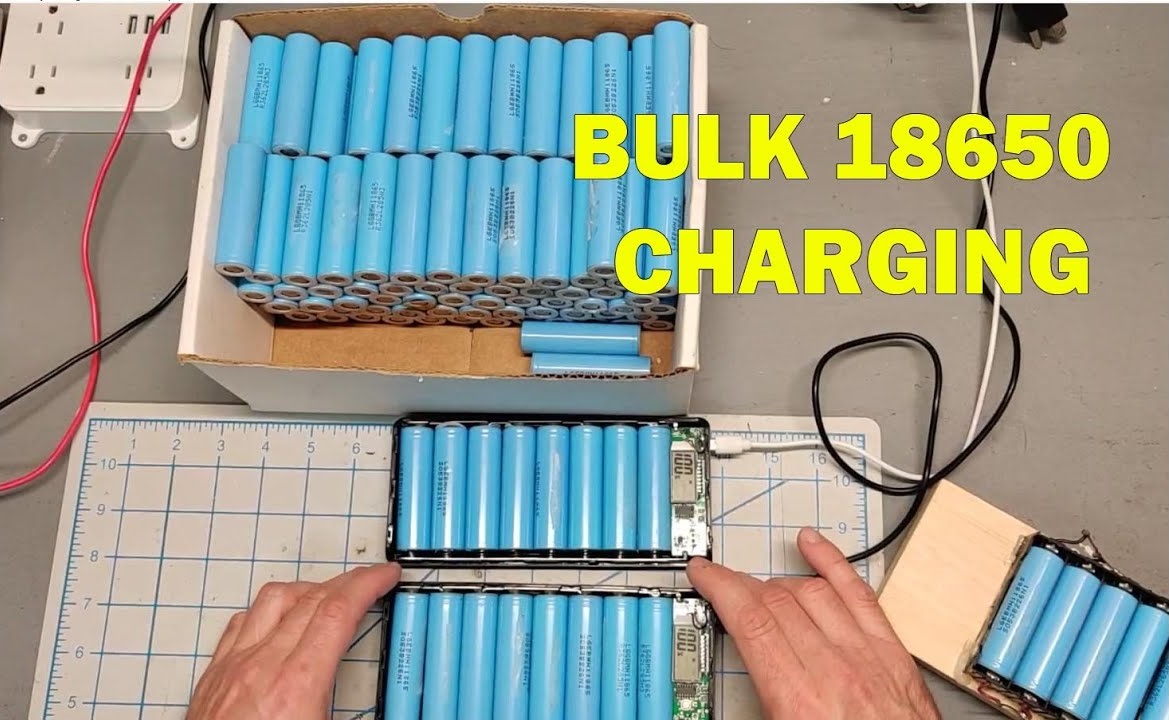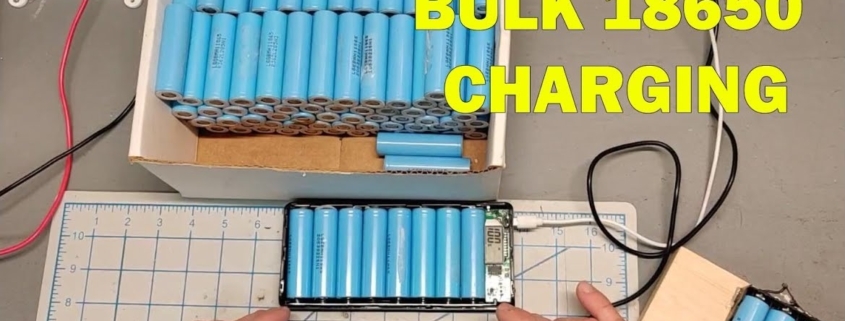How to Charge Two 18650 Batteries in Parallel? 6 Correct Steps Guide
Charging two 18650 batteries in parallel isn’t rocket science.
But mess it up? You’re looking at damaged batteries. Or worse.
The good news?
Once you understand the basics, parallel charging is actually pretty straightforward. And it’s an awesome way to double your battery capacity without increasing voltage.
In this guide, as a professional 18650 battery pack manufacturer, I’ll show you exactly how to charge two 18650 batteries in parallel safely and effectively.
Let’s dive right in.

What Is Parallel Battery Charging (And Why Should You Care)?
Here’s the deal:
When you connect two 18650 batteries in parallel, you’re basically creating one bigger battery.
The voltage stays the same (3.7V nominal). But the capacity? That doubles.
For example:
- Two 2500mAh batteries in parallel = 5000mAh total capacity
- Same 3.7V output
- Twice the runtime
Pretty sweet, right?
But here’s where most people screw up:
They think parallel charging is as simple as slapping two batteries together.
It’s not.
The Critical Safety Rules You Can’t Ignore
Look:
I’ve been working with lithium batteries for years. And I’ve seen some scary stuff happen when people cut corners.
So before we get into the how-to, let’s cover the non-negotiables.
Rule #1: Match Your Batteries
This is HUGE.
Your batteries need to be:
- Same brand and model
- Same capacity (mAh)
- Same age/charge cycles
- Within 0.1V of each other
Why?
Because mismatched batteries create dangerous current imbalances. The stronger battery tries to charge the weaker one. Fast.
And that leads to heat. Lots of it.
Rule #2: Check Voltage First
Never—and I mean NEVER—connect batteries with different voltage levels.
Here’s what happens:
Let’s say Battery A is at 4.2V (fully charged) and Battery B is at 3.0V (nearly empty).
Connect them? Battery A dumps current into Battery B like a fire hose.
The result? Overheating. Potential fire. Bad times all around.
Always measure with a multimeter first. If the difference is more than 0.1V, charge them separately until they match.
Rule #3: Use Protected Cells
Protected 18650s have a tiny circuit board that prevents:
- Overcharging
- Over-discharging
- Short circuits
- Excessive current draw
Yes, they cost a bit more. But they’re worth every penny for the peace of mind.
How to Charge Two 18650 Batteries in Parallel: Step-by-Step
Now for the good stuff.
Here’s exactly how to safely charge two 18650 batteries in parallel:
Step 1: Gather Your Equipment
You’ll need:
- Two matched 18650 batteries
- Digital multimeter
- Parallel battery holder or quality connecting wires
- Compatible lithium-ion charger (like a TP4056 module)
- Safety gear (fireproof charging bag recommended)
Pro tip: Don’t cheap out on the battery holder. A quality one with proper connections is worth the extra $5.
Step 2: Test Your Batteries
Before anything else, measure each battery’s voltage.
Use your multimeter’s DC voltage setting. Touch the positive probe to the positive terminal, negative to negative.
Write down both readings.
If they’re within 0.1V of each other, you’re good to go. If not, charge them individually first.
Step 3: Connect in Parallel
This is where the magic happens.
Connect:
- Positive terminal of Battery 1 to positive terminal of Battery 2
- Negative terminal of Battery 1 to negative terminal of Battery 2
If you’re using a parallel holder, just insert the batteries with correct polarity. The holder does the connecting for you.
Step 4: Set Up Your Charger
Here’s the thing:
Your charger sees the parallel pack as one big battery.
So if you’re using two 2500mAh cells, the charger sees a single 5000mAh battery.
Most TP4056 modules charge at 1A. For a 5000mAh pack, that’s a nice safe 0.2C charge rate.
Connect the charger’s positive output to your parallel pack’s positive terminal. Same for negative.
Step 5: Monitor the Process
Don’t just plug in and walk away.
Check on your batteries every 30 minutes or so. Feel for excessive heat. Look for swelling.
A bit of warmth is normal. But if they’re too hot to touch comfortably? Stop charging immediately.
Step 6: Verify Full Charge
Most chargers have an LED indicator. Red means charging, green means done.
But always double-check with your multimeter. Fully charged 18650s should read 4.2V.
Advanced Techniques for Better Results
Want to level up your parallel charging game?
Here are some pro moves:
Use a Battery Management System (BMS)
A BMS is like a bodyguard for your batteries.
It monitors:
- Individual cell voltages
- Temperatura
- Current flow
- Overall pack health
For permanent parallel setups, a BMS is non-negotiable.
Consider Charge Balancing
Even matched batteries can drift apart over time.
That’s where balance charging comes in.
Some advanced chargers can monitor and adjust individual cell voltages during charging. It keeps your batteries perfectly matched for maximum lifespan.
Track Your Cycles
Keep a log of:
- Charge dates
- Voltage readings
- Any issues noticed
This helps you spot problems before they become dangerous.
Common Mistakes That’ll Ruin Your Day
I’ve seen people make these mistakes over and over:
Mistake #1: Using Random Batteries
“Hey, both are 18650s, right?”
Wrong.
Mixing a Samsung 25R with a no-name cell from an old laptop? Recipe for disaster.
Always use identical cells. Period.
Mistake #2: Ignoring Temperature
Lithium batteries hate extreme temperatures.
Charging below 0°C (32°F)? You’re causing permanent damage through lithium plating.
Above 45°C (113°F)? Fire risk shoots way up.
Stick to room temperature charging whenever possible.
Mistake #3: Fast Charging Parallel Packs
Sure, that 4A fast charger will fill your batteries quickly.
But for parallel packs? It’s asking for trouble.
Stick to 0.5C or less. For two 2500mAh cells in parallel (5000mAh total), that means 2.5A maximum. But 1A is even safer.
Real-World Applications
So when does parallel charging actually make sense?
Here are the most common use cases I’ve seen:
DIY Power Banks
Building a custom power bank? Parallel 18650s are perfect.
You get extended capacity without needing a boost converter (since voltage stays at 3.7V).
High-Drain Devices
Vaping mods, high-powered flashlights, and RC cars often use parallel configurations.
Why? Because parallel batteries share the current load. Two 20A cells in parallel can safely deliver 40A.
Solar Storage Systems
Small solar setups often use parallel 18650 packs for energy storage.
The key here is using a proper solar charge controller designed for lithium batteries.
Troubleshooting Common Issues
Even with perfect technique, stuff happens.
Here’s how to fix the most common problems:
Problem: Batteries Won’t Hold Equal Charge
One battery always seems weaker than the other?
This usually means:
- Internal resistance mismatch
- One battery is aging faster
- Poor connection quality
Solution: Test each battery’s capacity individually. Replace the weak one.
Problem: Charging Takes Forever
If charging takes way longer than calculated:
- Check your charger’s actual output (some lie about specs)
- Verify connection quality
- Test battery health
Problem: Batteries Get Hot During Use
Some warmth is normal. But excessive heat means:
- Drawing too much current
- Internal damage
- Connection resistance
Reduce your current draw or replace the batteries.
The Bottom Line on Parallel Charging
Here’s the thing:
Parallel charging two 18650 batteries isn’t complicated. But it demands respect for safety.
Match your batteries. Check voltages. Use quality equipment. Monitor the process.
Do these things, and you’ll safely double your battery capacity without drama.
Skip them? Well, let’s just say fire extinguishers aren’t cheap.
The fact is:
With the right approach, parallel 18650 charging opens up tons of possibilities for DIY projects and commercial applications.
Just remember the golden rule: How to charge two 18650 batteries in parallel safely starts with matched cells and careful monitoring.
Take your time. Follow the steps. And enjoy your doubled capacity.
Because when done right? Parallel charging is a game-changer for battery-powered projects.








